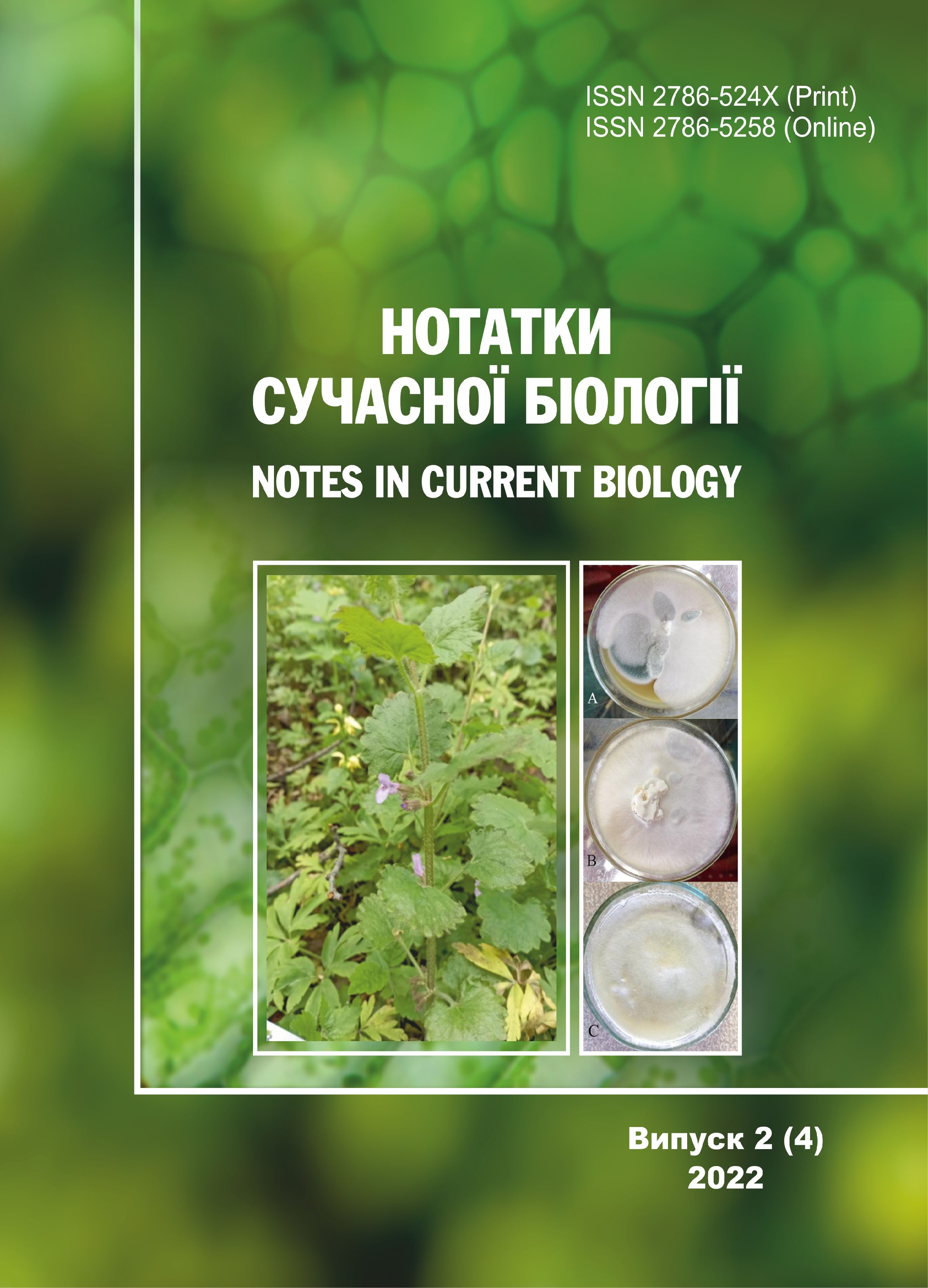Screening of some macromycetes cultures for their resistance to Penicillium sp. (Aspergillaceae)
DOI:
https://doi.org/10.29038/2617-4723-2022-2-7Keywords:
confrontation, fungal cultures, macromycetes, micromycete, strainsAbstract
The market of mushroom products is constantly developing and improving. An important criterion when choosing certain strains of mushrooms for their industrial cultivation is their bactericidal and fungicidal properties. These characteristics are especially important for consumers of products, because antibiotics and fungicides are used to fight infections in culture, their derivates can enter the consumer's body together with the growed mushrooms. Besides, good bactericidal and fungicidal properties reduce the final market price of finished products. The aim of the work was to analyze some strains of fungi for their ability to counteract Penicillium sp. in conditions of the confrontation. The various variants of confrontational interactions in culture were investigated between Penicillium sp. and strains of Hericium coralloides 2332, H. coralloides 2333, Sparassis nemecii 2327, S. laminosa 2211, Polyporus umbellatus 2510, P. umbellatus 2511, Fomitopsis officinalis 5004, F. officinalis 2498, F. officinalis 2497, Flammulina velutipes CU. Strains of macromycete which mycelium growth over micromycete mycelium in culture we considered the most promising of further research into their fungicidal properties and use for cultivation on a commercial scale. It was established the ability to counteract Penicillium sp. is expressed differently in the studied species, which indicates the importance of screening cultures for their resistance to micromycetes. Equivalent antagonistic properties have been established between Penicillium sp. and P. umbellatus, Penicillium sp. and S. nemecii. The antagonistic properties of the micromycete prevail in binary compositions of Penicillium sp.− H. coralloides, Penicillium sp. – F. velutipes. Species that seem promising in terms for cultivation or/and for further research into their fungicidal properties and use are S. laminosa and F. officinalis, the antagonistic properties of which prevail when co-cultivated with a micromycete.
References
Morozov, A.I. Bolshaya gribnaya entsiklopediya. M.: AST; Donetsk: Stalker, 2005; s. 32,33.
Vovk, M. Are the antibiotics added when growing mushrooms? 2020-onward. Available at: https://labprice.ua/statti/chi-dodayut-antibiotiki-pri-viroshhuvanni-gribiv/ (Accessed 27 June 2022).
Bellettinia, M. B.; Fiordaa, F. A.; Maievesa, H. A.; Teixeiraa, G. L.; Avilla, S.; Hornunga, P. S.; Juniorb, A. M.; Ribania, R. H. Factors affecting mushroom Pleurotus spp. Saudi Journal of Biological Sciences. 2019, 26, pp 633–646.
Bisko, N. A.; Lomberg, M. L.; Mytropolska, N. Yu.; Mykchaylova, O. B. 2016. Kolektsiya kultur shapynkovykh hrybiv (IBK) (IBK Mushroom Culture Collection); Alterpress: Kyiv, 2016; s 37, 46.
Pasailiuk, M. V. Ksylotrofni aharykomitsety – antahonisty ridkisnoho hryba Hericium coralloides (Scop.) Pers. (Hericiaceae) v kulturi. Ukrainian Journal of Ecology 2017, 7(3), s 225−233. https://doi. 10.15421/2017_72
Gea, F. J.; Navarro, M. J.; Santos, M.; Diánez, F.; Carrasco, J. Control of Fungal Diseases in Mushroom Crops while Dealing with Fungicide Resistance: A Review. Microorganisms. 2021, 9, 585–608.
Adie, B.; Grogan, H.; Archer, S.; Mills, P. Temporal and spatial dispersal of Cladobotryum conidia in the controlled environment of a mushroom growing room. Applied and Environmental Microbiology. 2006, 72, pp 7212–7217.
Elkhateeb, W. A.; Daba, G. M.; Thomas, P. W.; Wen, T. C. Medicinal mushrooms as a new source of natural therapeutic bioactive compounds. Egyptian Pharmacic Journal. 2019, 18, pp 88–101.
Elkhateeb, W. A.; Daba, G. M.; Elmahdy, E. M.; Thomas, P. W.; Wen, T-C.; Mohamed, N. S. Antiviral potential of mushrooms in the light of their biological active compounds. ARC Journal of Pharmaceutical Sciences (AJPS). 2019, 5(2), pp 45–49.
Kozarski, M.; Klaus, A.; Niksic, M.; Jakovljevic, D.; Helsper, J. P.; Van Griensven, L. J. Antioxidative and immunomodulation activities of polysaccharide extracts of the medicinal mushrooms Agaricus bisporus, Agaricus brasiliensis, Ganoderma lucidum and Phellinus linteus. Food Chemistry. 2011, 129, pp 1667–1675.
Minato, K. I.; Laan, L. C.; van Die, I.; Mizuno, M. Pleurotus citrinopileatus polysaccharide stimulates anti-inflammatory properties during monocyteto-macrophage differentiation. International Journal of Biological Macromoleculs. 2019, 122, pp 705–712.
Ruan, W.; Popovich, D. G. Ganoderma lucidum triterpenoid extract induces apoptosis in human colon carcinoma cells (Caco-2). Biomedicine and Preventive Nutrition. 2012, 2(3), pp 203–209.
Pasailiuk, M.V.; Sukhomlyn, M. M.; Fontana, N. M. Influence of rutin on fruiting of Hericium coralloides, Polyporus umbellatus, and Flammulina velutipes. Mycologia. 2022, 114, pp 467-475.
Girometta, C. Antimicrobial properties of Fomitopsis officinalis in the light of its bioactive metabolites: a review. Mycology, 2019, 10, pp 32–39.
Sukhomlyn, M. M. Skryninh hrybiv-antahonistiv korenevoi hubky. Scientific Bulletin of the National Agrarian University. Forestry 2000, 27, s 296−299.
Keller, C.; Maillard, M.; Keller, J.; Hostettmann, K. Screening of European Fungi for Antibacterial, Antifungal, Larvicidal, Molluscicidal, Antioxidant and Free-Radical Scavenging Activities and Subsequent Isolation of Bioactive Compounds. Pharmaceutical Biology. 2002, 40(7), pp 518−525. https://doi.org.10.1076/phbi.40.7.518.14680
Kimura, T. Natural products and biological activity of the pharmacologically active cauliflower mushroom Sparassis crispa. BioMed Research International. 2013. pp 377−382.
Pasailiuk, M. V. Kultyvuvannia Sparassis laminosa na roslynnykh substratakh. Notatky suchasnoi biolohii 2021, 1(1), s 9–14.
Zhang, G.; Zeng, X.; Li, C.; Li, J.; Huang, Y.; Han, L.; Wei, J. A.; Huang, H. Inhibition of urinary bladder carcinogenesis by aqueous extract of sclerotia of Polyporus umbellatus fries and polyporus polysaccharide. The American Journal of Chinese Medicine. 2011, 39(1), pp 135–144.
Wang, Y.; Bao, L.; Yang, X.; Li, L.; Li, S.; Gao, H.; Yao, X. S.; Wen, H.; Liu, H. W. Bioactive sesquiterpenoids from the solid culture of the edible mushroom Flammulina velutipes growing on cooked rice. Food Chemistry. 2012, 132(3), pp 1346−1353.
Downloads
Published
Issue
Section
License

This work is licensed under a Creative Commons Attribution-NonCommercial 4.0 International License.





